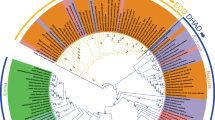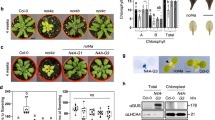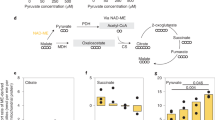Abstract
Pyruvate serves as a metabolic precursor for many plastid-localized biosynthetic pathways, such as those for fatty acids1, terpenoids2 and branched-chain amino acids3. In spite of the importance of pyruvate uptake into plastids (organelles within cells of plants and algae), the molecular mechanisms of this uptake have not yet been explored. This is mainly because pyruvate is a relatively small compound that is able to passively permeate lipid bilayers4, which precludes accurate measurement of pyruvate transport activity in reconstituted liposomes. Using differential transcriptome analyses of C3 and C4 plants of the genera Flaveria and Cleome, here we have identified a novel gene that is abundant in C4 species, named BASS2 (BILE ACID:SODIUM SYMPORTER FAMILY PROTEIN 2). The BASS2 protein is localized at the chloroplast envelope membrane, and is highly abundant in C4 plants that have the sodium-dependent pyruvate transporter. Recombinant BASS2 shows sodium-dependent pyruvate uptake activity. Sodium influx is balanced by a sodium:proton antiporter (NHD1), which was mimicked in recombinant Escherichia coli cells expressing both BASS2 and NHD1. Arabidopsis thaliana bass2 mutants lack pyruvate uptake into chloroplasts, which affects plastid-localized isopentenyl diphosphate synthesis, as evidenced by increased sensitivity of such mutants to mevastatin, an inhibitor of cytosolic isopentenyl diphosphate biosynthesis. We thus provide molecular evidence for a sodium-coupled metabolite transporter in plastid envelopes. Orthologues of BASS2 can be detected in all the genomes of land plants that have been characterized so far, thus indicating the widespread importance of sodium-coupled pyruvate import into plastids.
This is a preview of subscription content, access via your institution
Access options
Subscribe to this journal
Receive 51 print issues and online access
$199.00 per year
only $3.90 per issue
Buy this article
- Purchase on Springer Link
- Instant access to full article PDF
Prices may be subject to local taxes which are calculated during checkout




Similar content being viewed by others
Change history
17 October 2011
Parts of the Supplementary Information were inadvertently not uploaded and the file was also corrupted; this has been corrected.
References
Schwender, J., Ohlrogge, J. & Shachar-Hill, Y. Understanding flux in plant metabolic networks. Curr. Opin. Plant Biol. 7, 309–317 (2004)
Hemmerlin, A. et al. Cross-talk between the cytosolic mevalonate and the plastidial methylerythritol phosphate pathways in tobacco Bright Yellow-2 cells. J. Biol. Chem. 278, 26666–26676 (2003)
Schulze-Siebert, D., Heineke, D., Scharf, H. & Schultz, G. Pyruvate-derived amino acids in spinach chloroplasts: synthesis and regulation during photosynthetic carbon metabolism. Plant Physiol. 76, 465–471 (1984)
Proudlove, M. O. & Thurman, D. A. The uptake of 2-oxoglutarate and pyruvate by isolated pea chloroplasts. New Phytol. 88, 255–264 (1981)
Bräutigam, A., Hoffmann-Benning, S. & Weber, A. P. M. Comparative proteomics of chloroplast envelopes from C3 and C4 plants reveals specific adaptations of the plastid envelope to C4 photosynthesis and candidate proteins required for maintaining C4 metabolite fluxes. Plant Physiol. 148, 568–579 (2008)
Huber, S. C. & Edwards, G. E. Transport in C4 mesophyll chloroplasts. Characterization of the pyruvate carrier. Biochim. Biophys. Acta 462, 583–602 (1977)
Flügge, U. I., Stitt, M. & Heldt, H. W. Light-driven uptake of pyruvate into mesophyll chloroplasts from maize. FEBS Lett. 183, 335–339 (1985)
Ohnishi, J. & Kanai, R. Pyruvate uptake induced by a pH jump in mesophyll chloroplasts of maize and sorghum, NADP-malic enzyme type C4 species. FEBS Lett. 269, 122–124 (1990)
Ohnishi, J. & Kanai, R. Na+-induced uptake of pyruvate into mesophyll chloroplasts of a C4 plant, Panicum miliaceum . FEBS Lett. 219, 347–350 (1987)
Aoki, N., Ohnishi, J. & Kanai, R. Two different mechanisms for transport of pyruvate into mesophyll chloroplasts of C4 plants — a comparative study. Plant Cell Physiol. 33, 805–809 (1992)
Weber, A. P. M. & von Caemmerer, S. Plastid transport and metabolism of C3 and C4 plants — comparative analysis and possible biotechnological exploitation. Curr. Opin. Plant Biol. 13, 1–9 (2010)
McKown, A. D., Moncalvo, J.-M. & Dengler, N. G. Phylogeny of Flaveria (Asteraceae) and inference of C4 photosynthesis evolution. Am. J. Bot. 92, 1911–1928 (2005)
Sawada, Y. et al. Arabidopsis bile acid:sodium symporter family protein 5 is involved in methionine-derived glucosinolate biosynthesis. Plant Cell Physiol. 50, 1579–1586 (2009)
Gigolashvili, T. et al. The plastidic bile acid transporter 5 is required for the biosynthesis of methionine-derived glucosinolates in Arabidopsis thaliana . Plant Cell 21, 1813–1829 (2009)
Cellier, F. et al. Characterization of AtCHX17, a member of the cation/H+ exchangers, CHX family, from Arabidopsis thaliana suggests a role in K+ homeostasis. Plant J. 39, 834–846 (2004)
Bräutigam, A. et al. An mRNA blueprint for C4 photosynthesis derived from comparative transcriptomics of closely related C3 and C4 species. Plant Physiol. 155, 142–156 (2011)
Majeran, W. et al. Consequences of C4 differentiation for chloroplast membrane proteomes in maize mesophyll and bundle sheath cells. Mol. Cell. Proteomics 7, 1609–1638 (2008)
Weber, A. P. M., Schwacke, R. & Flügge, U. I. Solute transporters of the plastid envelope membrane. Annu. Rev. Plant Biol. 56, 133–164 (2005)
Suzuki, M. et al. Loss of function of 3-hydroxy-3-methylglutaryl coenzyme A reductase 1 (HMG1) in Arabidopsis leads to dwarfing, early senescence and male sterility, and reduced sterol levels. Plant J. 37, 750–761 (2004)
Aoki, N. & Kanai, R. Reappraisal of the role of sodium in the light-dependent active transport of pyruvate into mesophyll chloroplasts of C4 plants. Plant Cell Physiol. 38, 1217–1225 (1997)
Sugden, M. C. & Holness, M. J. Trials, tribulations and finally, a transporter: the identification of the mitochondrial pyruvate transporter. Biochem. J. 374, e1–e2 (2003)
Furumoto, T., Hata, S. & Izui, K. cDNA cloning and characterization of maize phosphoenolpyruvate carboxykinase, a bundle sheath cell-specific enzyme. Plant Mol. Biol. 41, 301–311 (1999)
Furumoto, T. et al. Vascular-tissue abundant expression of plant TAF10, an orthologous gene for TATA box-binding protein-associated factor 10, in Flaveria trinervia and abnormal morphology of Arabidopsis thaliana transformants on its over-expression. Plant Cell Physiol. 46, 108–117 (2005)
Weber, A. P. M., Weber, K. L., Carr, K., Wilkerson, C. & Ohlrogge, J. B. Sampling the Arabidopsis transcriptome with massively parallel pyrosequencing. Plant Physiol. 144, 32–42 (2007)
Furumoto, T., Izui, K., Quinn, V., Furbank, R. T. & von Caemmerer, S. Phosphorylation of phosphoenolpyruvate carboxylase is not essential for high photosynthetic rates in the C4 species Flaveria bidentis . Plant Physiol. 144, 1936–1945 (2007)
Padan, E., Maisler, N., Taglicht, D., Karpel, R. & Schuldiner, S. Deletion of ant in Escherichia coli reveals its function in adaptation to high salinity and an alternative Na+/H+ antiporter system(s). J. Biol. Chem. 264, 20297–20302 (1989)
Pavón, L. R. et al. Arabidopsis ANTR1 is a thylakoid Na-dependent phosphate transporter. J. Biol. Chem. 283, 13520–13527 (2008)
Tsuchiya, T., Hasan, S. M. & Raven, J. Glutamate transport driven by an electrochemical gradient of sodium ions in Escherichia coli . J. Bacteriol. 131, 848–853 (1977)
Tamada, Y. et al. Temporary expression of the TAF10 gene and its requirement for normal development of Arabidopsis thaliana . Plant Cell Physiol. 48, 134–146 (2007)
Acknowledgements
We thank G. Schönknecht, S. Yamaguchi and Y. Kamiya for discussions; N. Das, S. von Caemmerer and R. T. Furbank for critical reading of the manuscript; R. F. Sage, T. Endo, M. Munekage, J. Hibberd and M. Ku for gifts of seeds; T. Kinoshita for technical advice on the BASS2 immunoblot analysis; N. Aoki and S. Koreeda for technical advice on the pyruvate-uptake measurements; A. Izumida for preparation of the F. trinervia cDNA library; and Y. Takahashi for suggesting the dual expression system. This work was supported in part by the Ministry of Education, Science and Culture of Japan (Grants-in-Aid for Scientific Research to T.F. and K.I.), by a Sasakawa Scientific Research Grant from the Japan Science Society to T.F., and by the German Research Foundation (CRC-TR1 and IRTG 1525/1 to A.P.M.W., and CRC 590 to P.W.).
Author information
Authors and Affiliations
Contributions
T.Y. performed the differential screening and isolated the BASS2 gene. M.N. and Y.O.-I. analysed C4-abundant genes. Y.O.-I. prepared the bass2 mutants and revealed BASS2 expression. M.S. performed the confocal laser micro-scanning and the analyses of immunohistochemistry. J.O. and T.F. performed the pyruvate-uptake measurements on isolated chloroplasts, and A.B., A.P.M.W. and T.F. performed the E. coli whole-cell uptake measurements. U.G., P.W., A.B. and A.P.M.W. performed Flaveria and Cleome transcriptome analyses and the phylogenic analysis. S.H. was involved in designing the study, T.F. and K.I. designed the study, and T.F. and A.P.M.W. wrote the paper.
Corresponding author
Ethics declarations
Competing interests
The authors declare no competing financial interests.
Supplementary information
Supplementary Information
The file contains Supplementary Text, Supplementary References and Supplementary Figures 1-12 with legends. This file was replaced on 17 October 2011 as the Supplementary Text and Supplementary References were omitted from the original file posted on line. (PDF 4233 kb)
Rights and permissions
About this article
Cite this article
Furumoto, T., Yamaguchi, T., Ohshima-Ichie, Y. et al. A plastidial sodium-dependent pyruvate transporter. Nature 476, 472–475 (2011). https://doi.org/10.1038/nature10250
Received:
Accepted:
Published:
Issue Date:
DOI: https://doi.org/10.1038/nature10250
This article is cited by
-
Adjustment of light-responsive NADP dynamics in chloroplasts by stromal pH
Nature Communications (2023)
-
Integrated physiological and transcriptional dissection reveals the core genes involving nutrient transport and osmoregulatory substance biosynthesis in allohexaploid wheat seedlings under salt stress
BMC Plant Biology (2022)
-
Strain-specific transcriptional responses overshadow salinity effects in a marine diatom sampled along the Baltic Sea salinity cline
The ISME Journal (2022)
-
Bioenergetics of pollen tube growth in Arabidopsis thaliana revealed by ratiometric genetically encoded biosensors
Nature Communications (2022)
-
Salt stress induces Kranz anatomy and expression of C4 photosynthetic enzymes in the amphibious sedge Eleocharis vivipara
Photosynthesis Research (2022)
Comments
By submitting a comment you agree to abide by our Terms and Community Guidelines. If you find something abusive or that does not comply with our terms or guidelines please flag it as inappropriate.



